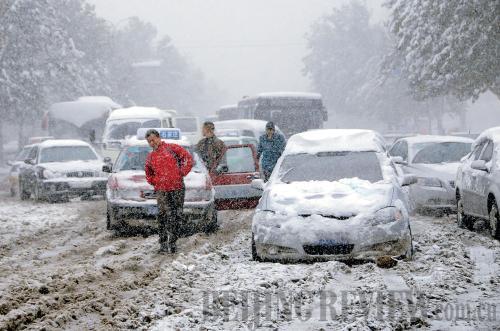|
 |
|
HEAVY SNOW: Shijiazhuang, capital of Hebei Province, saw an accumulation of 49 cm on November 11, the heaviest snowfall in the area in 54 years (GONG ZHIHONG) |
China was covered in an early and heavy blanket of snow this winter. Three days of snow have swept over north China, including Beijing, Tianjin, Shandong, Hebei and Jilin provinces, since November 1.
"The occurrence was rather rare for early November," said Sun Jisong, chief forecaster at the Beijing Meteorological Bureau.
Temperatures also dropped sharply by as much as 10 degrees Celsius on November 1, according to data from the National Meteorological Center (NMC).
Since November 8, heavy snow and blizzards had been reported in Shaanxi, central and southern parts of Shanxi and Hebei, northern and western parts of Henan, and in northwestern Hubei and Shandong provinces.
South and east China also saw snow on November 16 due to a cold front from the north. It was the first snowfall of the year for Anhui, Jiangsu and Jiangxi provinces.
The first snows in north China caused the cancellation of 68 flights at the Beijing Capital International Airport and delayed 33 others. Almost 4,000 police officers were dispatched around Beijing to direct traffic throughout the city.
Shijiazhuang, capital of Hebei, recorded 49 cm of snowfall on November 11, the heaviest snowstorm there in 54 years. Zhang Wenzong, Director of the Hebei Agri-Meteorological Center said that the drastic temperature drop has also harmed the province's 2.4 million hectares of wheat.
The heavy snow caused the death of 32 people, the collapse of 15,000 buildings and affected 9.6 million residents, according to the Ministry of Civil Affairs. The ministry said nearly 300,000 hectares of winter crops were destroyed. In all, severe weather caused direct economic losses of 7 billion yuan ($1 billion).
Among the 32 deaths, 10 were in Hebei, 12 in Henan and the remainder in Shanxi, Shandong and Shaanxi provinces. The death toll did not include those who were killed in snow-related traffic accidents. More than 165,000 people were evacuated from their homes or rescued from stranded vehicles.
Four children were among the 10 who died in Hebei, after their school's roof collapsed on them while they were having lunch in the building's cafeteria. Another collapsing school building caused the death of a boy in Henan.
One person was killed and 350,000 people were affected in Shandong. A total of 17 houses and about 40,000 greenhouses collapsed. Some 2,400 hectares of farmland were impacted in the province and direct economic losses climbed to 250 million yuan ($37 million), according to the Shandong Provincial Government.
Snowfall on November 16 affected about 663,000 residents in east China's Anhui, and caused direct economic losses totaling 60.8 million yuan ($8.9 million), according to the Anhui Provincial Government. In the central province of Hubei, heavy snow damaged 18,716 hectares of crops and caused the collapse of 878 houses. Almost 1,800 residents were relocated and direct economic losses rose to 74.8 million yuan ($11 million).
Civil Affairs Minister Li Xueju ordered authorities to provide food, water and clothing to stranded residents and to make arrangements for people whose homes were lost in the snow.
The ministries of civil affairs and finance moved 20 million yuan ($2.9 million) from the central budget to Shanxi and Hebei provinces to help relocate those affected by the weather and help them build new homes.
A circular issued on November 12 by the State Council, China's cabinet, called for stepped-up efforts to mitigate the damage brought on by the snow. Authorities should take measures to ensure adequate supplies of food, water, power, heating and gas to the public, and should check primary and middle schools, health centers, nursing homes and tourist sites for hidden dangers, the circular said. Timely help must also be provided to people who are having difficulties.
Meanwhile, public security and traffic departments should increase patrols on accident-prone roads and redouble efforts to maintain functioning expressways and highways, the circular said.
Authorities must also conduct thorough safety checks on power, telecommunications, heating, water and gas supply facilities, it said. The circular urged weather forecasting departments to publicize alerts for blizzards and temperature drops. | 